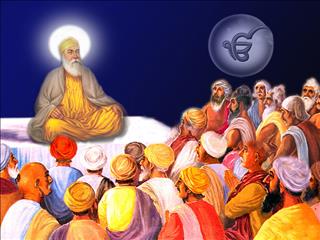The founder of the Sikh religion, Guru Nanak was born in 1469 in the Western Punjab village of Talwandi to a simple Hindu family.
His father, Mehta Kalian Das was an accountant employed by the local Muslim authorities.
From an early age, Guru Nanak made friends with both Hindu and Muslim children and was keen to learn the larger meaning of life.
At the age of six, he learnt Hindi, mathematics, Muslim literature, Persian and Arabic. He was an unusually gifted child who learned quickly and often sought clarifications from his teachers.
Guru Nanak created a sensation when he refused to perform the ‘sacred thread ceremony’ at the age of 13 according to the Hindu custom.
He sang the following poem: “Let mercy be the cotton, contentment the thread, Continence the knot and truth the twist. O, priest! If you have such a thread, do give it to me. It will not wear out, get soiled, burnt or lost. Says Nanak, blessed are those who go about wearing such a thread.”
Brilliant thinker
As a young man herding the family cattle, Guru Nanak would spend long hours absorbed in meditation and in religious discussions with Muslim and Hindu holy men who lived in the forests surrounding the village.
Thinking that if bound in marriage, he may evince interest in household affairs, his parents arranged his marriage with Sulakhani, daughter of a pious merchant.
Guru Nanak did not object as he felt that married life would not conflict with spiritual pursuits.
He sired two sons-Sri Chand in 1494 and Lakshmi Chand three years later.
He was persuaded by his parents to take up the job of an accountant in charge of the stores of the Muslim Governor of Sultanpur Daulat Khan Lodi.
Guru Nanak agreed and was joined by his family and an old Muslim childhood friend Mardana, a musician by profession.
The Revelation
He would work during the days but meditate and sing hymns accompanied by Mardana on the rabab (a string instrument) during early and later hours of each day.
According to records, God appeared before Guru Nanak and enlightened him.
In praise of the Lord, Guru Nanak uttered, “There is but One God, His name is Truth, He is the Creator, He fears none, he is without hate, He never dies, He is beyond the cycle of births and death, He is self-illuminated, He is realised by the kindness of the True Guru. He was True in the beginning, He was True when the ages commenced and has ever been True, He is also True now.”
These words are enshrined at the beginning of the Sikh Holy Scriptures, the Guru Granth Sahib. Guru Nanak did not believe in a Trinity of Gods or the belief that God can be born into human form.
Long Journeys
 Accompanied by his Muslim rabab player Mardana for company, Guru Nanak undertook long journeys to convey his message to the people in the form of musical hymns. Wherever he travelled, he used the local language to convey his message to the people.
Accompanied by his Muslim rabab player Mardana for company, Guru Nanak undertook long journeys to convey his message to the people in the form of musical hymns. Wherever he travelled, he used the local language to convey his message to the people.
The story is told of a visit to Saidpur in West Punjab, where he chose to stay with a low-caste carpenter. He incurred the wrath of the local chieftain, preferring the simple meal to his banquet.
When asked why he did not join in the feast, the Guru sent for the meal served by the chief and the simple meal served by poor man.
Holding these in separate hands he squeezed them, blood appeared out of the rich food of the rich man, while milk oozed out of the simple fare.
The chieftain realised that his riches had been amassed by exploiting the poor, while that of the poor man was through honest work.
On an eastern journey, Guru Nanak visited Gorakhmata where he discussed the true meaning of asceticism with some yogis.
“Asceticism does not lie in ascetic robes, walking staff, or in the ashes.
Asceticism does not lie in the earring, in the shaven head, or blowing a conch.
Asceticism lies in remaining pure amidst impurities.
Asceticism does not lie in mere words.
He is an ascetic who treats everyone alike.
Classless society
After having spent a lifetime of traveling abroad and setting up missions, an aged Guru Nanak returned home to Punjab. He settled down at Kartharpur with his wife and sons. Pilgrims came from far and near to hear the hymns and preaching of the Master. Here his followers would gather in the mornings and afternoons for religious services. He believed in a casteless society without any distinctions based on birthright, religion or sex. He institutionalised the common kitchen called ‘Langar’ in Sikhism. Here all can sit together and share a common meal, whether they were kings or beggars.
While working the fields one day in 1532, Guru Nanak was approached by a new devotee who said, “I am Lehna,” Guru Nanak looked at him and replied, “So you have arrived Lehna, the creditor. I have been waiting for you all these days. I must pay your debt.”
Feeling his end was near, Guru Nanak said; “You place flowers on either side, Hindus on my right, Muslims on my left. Those whose flowers remain fresh tomorrow will have their way.” He then asked them to pray and lay down covering himself with a sheet. Thus on September 22, 1539 in the early hours of the morning, Guru Nanak merged with the eternal light of the Creator.






